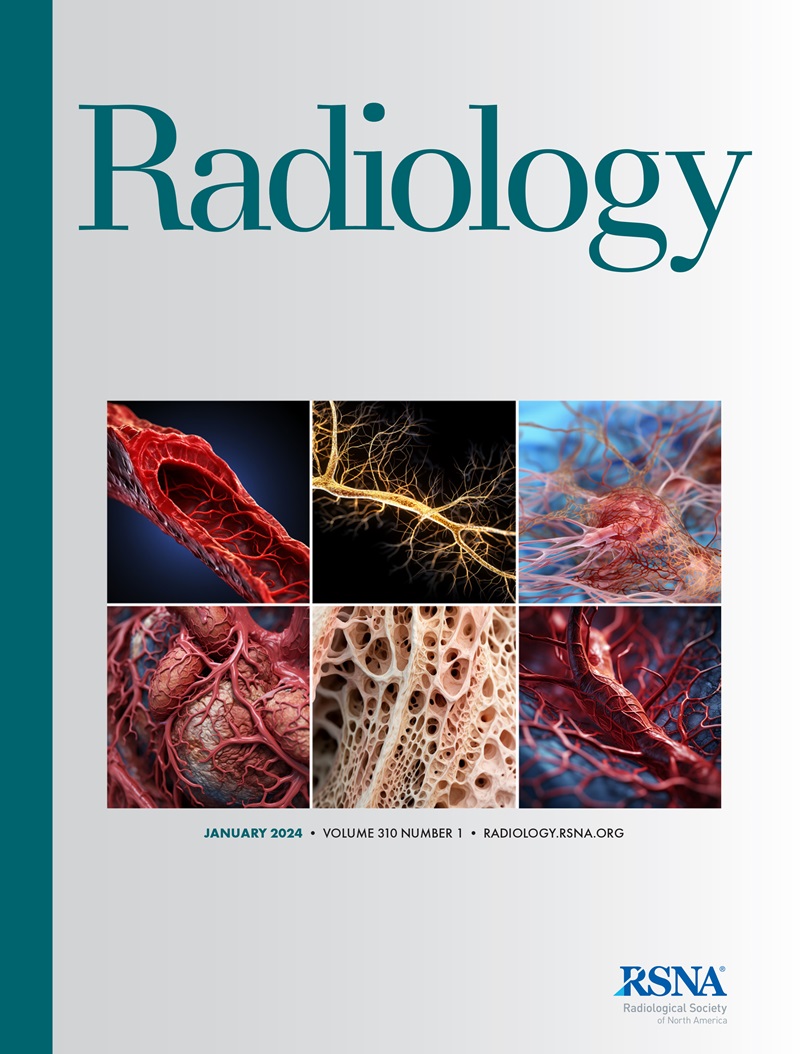Stefanie Weigel, Laura Khil, Hans-Werner Hense, Thomas Decker, Jürgen Wellmann, Jan Heidrich, Alexander Sommer, Oliver Heidinger, Walter Heindel
下载PDF
{"title":"两年一次数字乳房x线摄影筛查导管原位癌的检出率:放射学发现支持肿瘤进展的病理模型。","authors":"Stefanie Weigel, Laura Khil, Hans-Werner Hense, Thomas Decker, Jürgen Wellmann, Jan Heidrich, Alexander Sommer, Oliver Heidinger, Walter Heindel","doi":"10.1148/radiol.2017170673","DOIUrl":null,"url":null,"abstract":"<p><p>Purpose To compare detection rates of ductal carcinoma in situ (DCIS), classified according to nuclear grade, between the prevalence round (baseline screening) and two subsequent screening rounds of a population-based digital mammography screening program, to assess differences over time. Materials and Methods The cancer registry provided data for 1970 graded pure DCIS cases from 16 screening regions of the prevalence round (baseline screening, from 2005 to 2008), first subsequent round, and second subsequent round; the interval between all screening rounds was 22-30 months. Age-adjusted logistic regression analysis was performed to compare the grade-specific detection rates between the prevalence round (reference) and subsequent screening rounds. Results Over all screening rounds, cancer detection rates were lowest for low-grade DCIS (range, 0.11 [58 of 508 817 patients] to 0.25 [178 of 713 867 patients] per 1000 women screened) and highest for high-grade DCIS (range, 0.53[271 of 508 817 patients] to 0.59 [237 of 398 944 patients] per 1000 women screened). Detection rates for low-grade DCIS were significantly lower in the first (odds ratio [OR] = 0.45, P < .001) and second (OR = 0.57, P < .001) subsequent screening rounds compared with that in the prevalence round; the relative reduction of detection rates of intermediate-grade DCIS was less pronounced (OR = 0.79, P = .006 and OR = 0.76, P = .003, respectively). Conversely, the detection rate of high-grade DCIS remained at the high level found in the prevalence screening (OR = 0.89, P = .143 and OR = 0.97, P = .700, respectively). Conclusion The findings demonstrate persistently high detection rates of high-grade DCIS in two consecutive subsequent screening rounds compared with the prevalence round; conversely, rates of low-grade DCIS and, less markedly, intermediate-grade DCIS decreased in subsequent rounds. Grade-related changes of DCIS detection are suggestive of distinct dynamics of lesion progression. <sup>©</sup> RSNA, 2017 An earlier incorrect version of this article appeared online. This article was corrected on November 10, 2017.</p>","PeriodicalId":20896,"journal":{"name":"Radiology","volume":"286 2","pages":"424-432"},"PeriodicalIF":15.2000,"publicationDate":"2018-02-01","publicationTypes":"Journal Article","fieldsOfStudy":null,"isOpenAccess":false,"openAccessPdf":"https://sci-hub-pdf.com/10.1148/radiol.2017170673","citationCount":"16","resultStr":"{\"title\":\"Detection Rates of Ductal Carcinoma in Situ with Biennial Digital Mammography Screening: Radiologic Findings Support Pathologic Model of Tumor Progression.\",\"authors\":\"Stefanie Weigel, Laura Khil, Hans-Werner Hense, Thomas Decker, Jürgen Wellmann, Jan Heidrich, Alexander Sommer, Oliver Heidinger, Walter Heindel\",\"doi\":\"10.1148/radiol.2017170673\",\"DOIUrl\":null,\"url\":null,\"abstract\":\"<p><p>Purpose To compare detection rates of ductal carcinoma in situ (DCIS), classified according to nuclear grade, between the prevalence round (baseline screening) and two subsequent screening rounds of a population-based digital mammography screening program, to assess differences over time. Materials and Methods The cancer registry provided data for 1970 graded pure DCIS cases from 16 screening regions of the prevalence round (baseline screening, from 2005 to 2008), first subsequent round, and second subsequent round; the interval between all screening rounds was 22-30 months. Age-adjusted logistic regression analysis was performed to compare the grade-specific detection rates between the prevalence round (reference) and subsequent screening rounds. Results Over all screening rounds, cancer detection rates were lowest for low-grade DCIS (range, 0.11 [58 of 508 817 patients] to 0.25 [178 of 713 867 patients] per 1000 women screened) and highest for high-grade DCIS (range, 0.53[271 of 508 817 patients] to 0.59 [237 of 398 944 patients] per 1000 women screened). Detection rates for low-grade DCIS were significantly lower in the first (odds ratio [OR] = 0.45, P < .001) and second (OR = 0.57, P < .001) subsequent screening rounds compared with that in the prevalence round; the relative reduction of detection rates of intermediate-grade DCIS was less pronounced (OR = 0.79, P = .006 and OR = 0.76, P = .003, respectively). Conversely, the detection rate of high-grade DCIS remained at the high level found in the prevalence screening (OR = 0.89, P = .143 and OR = 0.97, P = .700, respectively). Conclusion The findings demonstrate persistently high detection rates of high-grade DCIS in two consecutive subsequent screening rounds compared with the prevalence round; conversely, rates of low-grade DCIS and, less markedly, intermediate-grade DCIS decreased in subsequent rounds. Grade-related changes of DCIS detection are suggestive of distinct dynamics of lesion progression. <sup>©</sup> RSNA, 2017 An earlier incorrect version of this article appeared online. This article was corrected on November 10, 2017.</p>\",\"PeriodicalId\":20896,\"journal\":{\"name\":\"Radiology\",\"volume\":\"286 2\",\"pages\":\"424-432\"},\"PeriodicalIF\":15.2000,\"publicationDate\":\"2018-02-01\",\"publicationTypes\":\"Journal Article\",\"fieldsOfStudy\":null,\"isOpenAccess\":false,\"openAccessPdf\":\"https://sci-hub-pdf.com/10.1148/radiol.2017170673\",\"citationCount\":\"16\",\"resultStr\":null,\"platform\":\"Semanticscholar\",\"paperid\":null,\"PeriodicalName\":\"Radiology\",\"FirstCategoryId\":\"3\",\"ListUrlMain\":\"https://doi.org/10.1148/radiol.2017170673\",\"RegionNum\":1,\"RegionCategory\":\"医学\",\"ArticlePicture\":[],\"TitleCN\":null,\"AbstractTextCN\":null,\"PMCID\":null,\"EPubDate\":\"2017/11/6 0:00:00\",\"PubModel\":\"Epub\",\"JCR\":\"Q1\",\"JCRName\":\"RADIOLOGY, NUCLEAR MEDICINE & MEDICAL IMAGING\",\"Score\":null,\"Total\":0}","platform":"Semanticscholar","paperid":null,"PeriodicalName":"Radiology","FirstCategoryId":"3","ListUrlMain":"https://doi.org/10.1148/radiol.2017170673","RegionNum":1,"RegionCategory":"医学","ArticlePicture":[],"TitleCN":null,"AbstractTextCN":null,"PMCID":null,"EPubDate":"2017/11/6 0:00:00","PubModel":"Epub","JCR":"Q1","JCRName":"RADIOLOGY, NUCLEAR MEDICINE & MEDICAL IMAGING","Score":null,"Total":0}
引用次数: 16
引用
批量引用

 求助内容:
求助内容: 应助结果提醒方式:
应助结果提醒方式:


